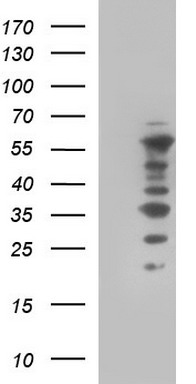WIPF1 Rabbit Polyclonal Antibody
Other products for "WIPF1"
Specifications
| Product Data | |
| Applications | IHC, WB |
| Recommended Dilution | WB 1:5000~20000, IHC 1:150,ELISA 1:100-1:2000 |
| Reactivities | Human, Mouse |
| Host | Rabbit |
| Isotype | IgG |
| Clonality | Polyclonal |
| Immunogen | DNA immunization. This antibody is specific for the Middle Region of the target protein. |
| Formulation | 20 mM Potassium Phosphate, 150 mM Sodium Chloride, pH 7.0 |
| Concentration | 1.2mg/ml |
| Purification | Purified from mouse ascites fluids or tissue culture supernatant by affinity chromatography (protein A/G) |
| Conjugation | Unconjugated |
| Storage | Store at -20°C as received. |
| Stability | Stable for 12 months from date of receipt. |
| Gene Name | WAS/WASL interacting protein family member 1 |
| Database Link | |
| Background | WIPF1 is involved in the organization of the actin cytoskeleton. The protein binds to a region of Wiskott-Aldrich syndrome protein that is frequently mutated in Wiskott-Aldrich syndrome, an X-linked recessive disorder. Impairment of the interaction between these WIPF1 and Wiskott-Aldrich syndrome protein may contribute to the disease. Two transcript variants encoding the same protein have been identified for this gene. WIPF1 binds to Wiskott-Aldrich syndrome protein, profilin and actin. It is involved with NCK1 and GRB2 in the recruitment and activation of N-WASP and may be involved in regulating the subcellular localization of N-WASP, resulting in the disassembly of stress fibers in filopodia formation. |
| Synonyms | PRPL-2; WAS2; WASPIP; WIP |
| Note | This antibody was generated by SDIX's Genomic Antibody Technology ® (GAT). Learn about GAT |
| Reference Data | |
Documents
| Product Manuals |
| FAQs |
{0} Product Review(s)
0 Product Review(s)
Submit review
Be the first one to submit a review
Product Citations
*Delivery time may vary from web posted schedule. Occasional delays may occur due to unforeseen
complexities in the preparation of your product. International customers may expect an additional 1-2 weeks
in shipping.






























































































































































































































































 Germany
Germany
 Japan
Japan
 United Kingdom
United Kingdom
 China
China





